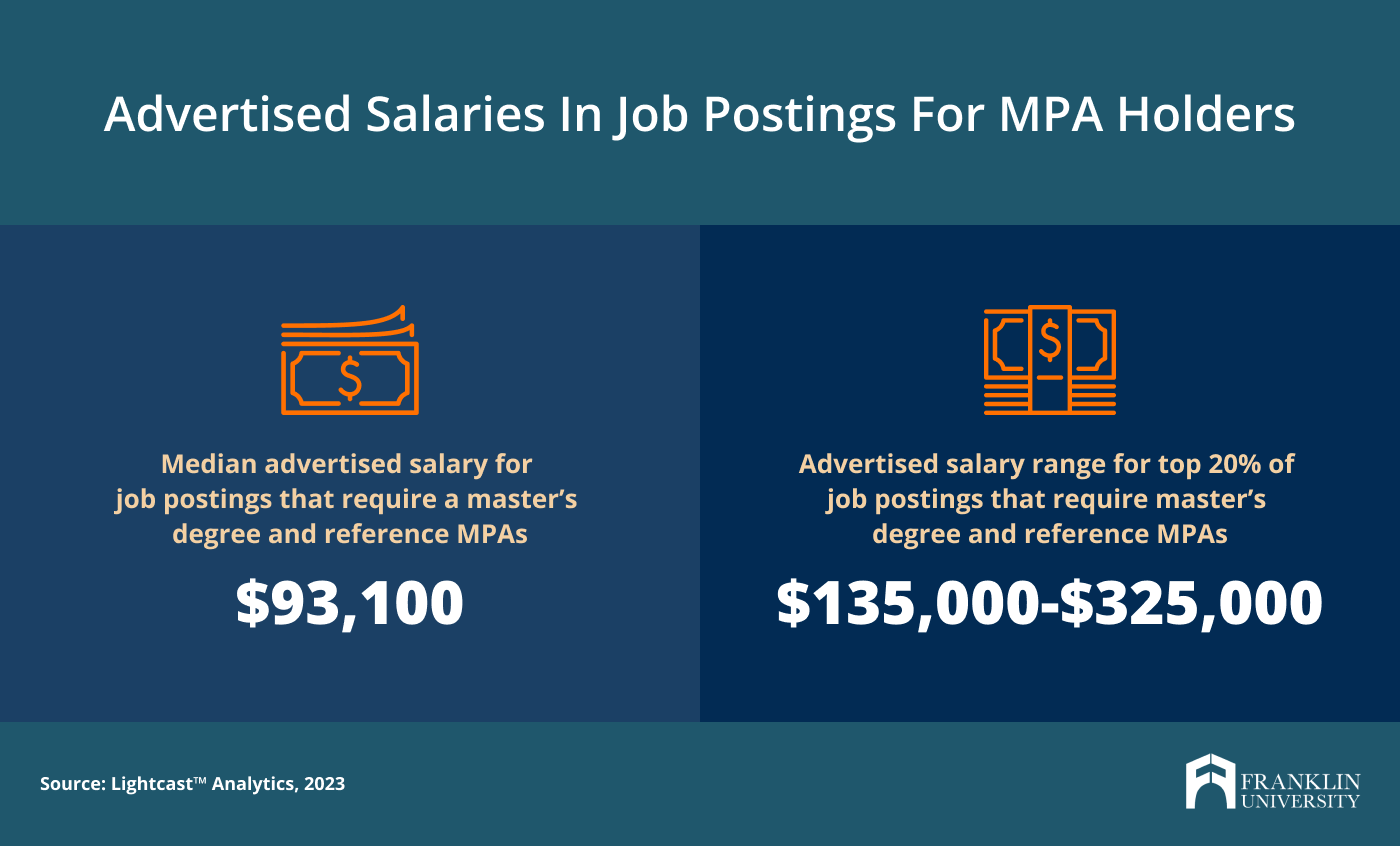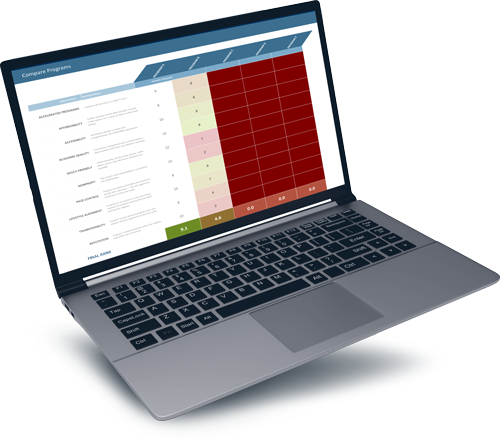Request Information
We're Sorry
There was an unexpected error with the form (your web browser was unable to retrieve some required data from our servers). This kind of error may occur if you have temporarily lost your internet connection. If you're able to verify that your internet connection is stable and the error persists, the Franklin University Help Desk is available to assist you at helpdesk@franklin.edu, 614.947.6682 (local), or 1.866.435.7006 (toll free).
Just a moment while we process your submission.

Is a Master of Public Administration (MPA) Worth It?
For many purpose-driven professionals, a career in public service or nonprofits is a natural choice. And since approximately a quarter of U.S. employees work for government agencies or nonprofits, this field holds an impressive number and range of opportunities.
If you’re hoping to enter public administration or prepare for leadership positions in the field, you may be considering a Master of Public Administration (MPA). But what exactly does this degree involve, and how can you decide if it’s right for you?
What is a Master of Public Administration?
An MPA is a graduate degree focused on public sector leadership. Just as an MBA degree teaches business professionals the skills they need for managerial roles, an MPA prepares public servants to take on increasing responsibility in government agencies and nonprofits.
Like MBAs, MPA programs include coursework related to human resource management, financial management of organizations and strategic planning. However, these programs look at those topics through the lens of public and nonprofit organizations, with the ultimate goal of driving social impact rather than profit. MPA programs also focus on public policy, ethical decision-making, public management and other considerations specific to the sector.
Some MPA programs, like Franklin University’s Master of Public Administration, offer additional coursework to prepare students for leadership roles in fields like nonprofit healthcare, criminal justice or employee relations.

Who Is a Master of Public Administration for?
The MPA degree is designed for current and aspiring government and nonprofit professionals. Individuals with significant management responsibilities and those who wish to move into management positions may find this degree a particularly good fit. Some members of the military pursue an MPA to help them rise through the ranks or prepare for life after active duty.
An MPA can also be a good choice for private sector professionals who work closely with government agencies or nonprofit organizations in sectors like healthcare or who work for companies with extensive government contracts.
“Franklin’s MPA program is a practical graduate degree with real-world scenario-based assignments and engaging discussions,” says Dr. Wendy Eaton, chair of Franklin’s Master of Public Administration program. “It emphasizes professional knowledge, skills and abilities that help ensure our graduates are capable of serving as effective, accountable leaders and managers in government and nonprofit organizations.”
Thinking about applying for grad school? Get an inside look at how to create a winning admission essay with this free report.
How Much Does a Master of Public Administration Cost?
The cost of an MPA degree varies significantly by institution and between online and in-person programs. It is often challenging to calculate a degree's total cost since hidden costs like student service fees and parking can add up quickly. It’s also important to consider indirect costs such as moving to an in-person program or losing income if your degree program’s scheduling doesn’t allow you to maintain your regular work hours.
Franklin University’s online MPA costs less than $26,000 in total, and the university’s tuition guarantee means that your tuition rate is fixed as long as you remain enrolled. That means you know exactly what you owe upfront and never need to worry about rising prices or hidden fees. Plus, Franklin’s highly flexible schedule is designed for professionals, so you can keep working – and earning – while you study.
How Long Does a Master of Public Administration Take?
Most MPA degree programs require two years of full-time study or three or more years of part-time study. If you’re eager to advance your career faster, an accelerated program may be right for you. Franklin’s MPA program can be completed online in as few as 17 months while still allowing you to balance personal and professional commitments. If you hold credits from previous graduate-level study, you may be able to graduate even faster thanks to Franklin’s generous transfer credit policy.
What Can You Do with an MPA?
An MPA can prepare you for a diverse range of positions, including fulfilling and lucrative positions in government, nonprofits or the private sector. A few potential roles include:
Budget analyst
- Median advertised salary: $65,200
Budget analysts help nonprofits allocate funding between different departments, programs and priorities. They also track spending and help the organization find ways to save money.
Social services manager
- Median advertised salary: $66,300
Social services managers plan and oversee a community organization or agency’s services and offerings, often in areas related to health and welfare.
Nonprofit director
- Median advertised salary: $88,800
A nonprofit director heads a nonprofit organization or a department within a nonprofit and is responsible for setting and implementing the nonprofit or department’s goals, overseeing staffing and programming, setting budgets and more.
Director of development
- Median advertised salary: $94,600
Development directors manage and oversee an organization’s fundraising operations. Typically, these roles are found in nonprofits and higher education institutions.
Policy director
- Median advertised salary: $100,100
Policy directors manage an organization’s relationships with local, state and federal officials. This can include analyzing new and existing legislation and planning the organization’s response if the legislation is relevant to its work.
Director of economic development
- Median advertised salary: $103,200
A director of economic development works for a city, county or state to help grow the local economy. They typically work closely with other government administrators as well as the private sector.
Director of public affairs
- Median advertised salary: $103,700
A public affairs director is responsible for communicating a government agency or department’s activities and priorities, including by interfacing with the public and the press.
City manager
- Median advertised salary: $159,600
City managers oversee a town or city’s administration, direct the activities of its various departments, manage its budget and more. While this role overlaps politics and administration, it is typically an appointed role rather than elected.
Is an MPA Right for You?
For many graduates, a Master of Public Administration can offer increased access to higher-paying roles and positions with increased leadership and management responsibilities. By equipping you with the skills you need to build effective organizations and programs, the degree can also help you maximize your career’s impact.
That said, the decision to pursue an MPA is highly personal. Factors to consider include your career goals and aspirations as well as your capacity to invest time and money in a degree program. As you explore your options, consider reviewing job postings for your target positions or speaking with trusted professionals in the field to better understand the skills and qualifications you need to achieve your goals.
Start Your Journey to an MPA
When you’re ready to embark on a Master of Public Administration degree, Franklin University can help. Franklin’s MPA program is designed and taught by leading government and nonprofit professionals who share your passion for public service.
Franklin’s flexible online format means you can graduate in as few as 17 months and increase your impact sooner. Learn more about how you can change your community for the better with an MPA from Franklin University.






